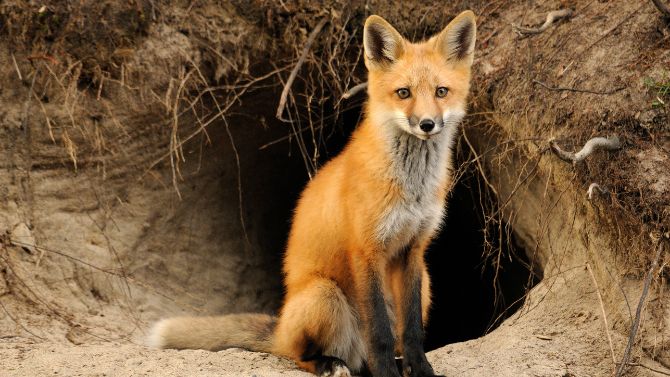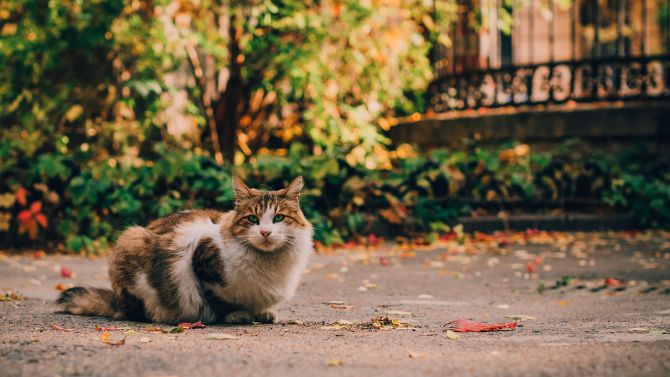The intriguing relationship between foxes and domestic cats has long piqued the curiosity of many. For cat owners living near wooded areas or in urban environments where foxes roam, the question “Do foxes attack and eat cats?” is of particular concern.
This article discusses the interactions between these two species, providing valuable insights into their behaviors and interactions. Let’s debunk myths and get to the heart of the matter.
The Basics You Should Know About Foxes
Foxes, with their sly expressions and bushy tails, belong to the Canidae family, which also includes dogs, wolves, and other similar animals. Known for their adaptability, foxes are found in diverse habitats ranging from deserts to forests.
Characteristics and Behavior
Foxes are omnivores, consuming a diet rich in fruits, insects, small mammals, and birds. Their keen sense of hearing, sharp eyesight, and strong sense of smell make them exceptional hunters. Most fox species tend to be nocturnal or crepuscular, preferring to hunt and move about during the cooler parts of the day.
- Diet: Foxes have a varied diet that includes rodents, rabbits, birds, and even fruits.
- Adaptability: They’ve been known to adapt to urban settings, often scavenging for food in rubbish bins or gardens.
Foxes in Urban Settings
In many parts of the world, urban foxes have become a common sight. Unlike their rural counterparts, urban foxes are more accustomed to human presence, which can lead to fascinating interactions. However, their adaptability has also raised concerns among pet owners.
- Visibility: It’s not uncommon to spot foxes rummaging through gardens or wandering streets at night.
- Interactions with Pets: While many urban foxes are wary of larger animals, there are occasional reports of confrontations with pets.
Cats and Their Instincts

Cats, beloved for their independence and agility, are natural predators. Anyone who has observed a cat pouncing on a toy or chasing after a butterfly knows about their innate hunting prowess. We have recently also written about a cat’s lifespan, so make sure to check it out.
Feline Behavior and Territory
Domestic cats, while often affectionate and playful, retain many of the instincts of their wild ancestors. The territory is of immense importance to them, and they mark their domains with scent glands located on their cheeks, paws, and the base of their tail.
- Hunting Instinct: Even well-fed domestic cats might chase after birds, insects, or small mammals, driven by instinct.
- Territorial Behavior: Cats can become quite protective of their marked territories, often confronting other cats or animals that encroach upon their space.
Cats and Their Nightly Adventures
Many cat owners who allow their felines outdoor access note that their pets are especially active during dawn and dusk. These twilight hours, known as the crepuscular period, coincide with the active hours of many small mammals and birds, making it prime hunting time for cats.
- Outdoor Risks: Venturing outdoors exposes cats to various dangers, from traffic accidents to encounters with wild animals.
- Fox Encounters: While cats and foxes might cross paths, especially during these active hours, direct confrontations are relatively rare.
Do Foxes Really Pose a Threat to Cats?
The crux of our exploration brings us to the most pertinent question: Are foxes a genuine threat to our feline friends?

Analyzing Reported Incidents
Though there have been isolated reports of foxes attacking or even eating cats, these incidents are the exception rather than the rule. Most confrontations between the two animals occur because of territorial disputes or when a mother fox is defending her young.
- Rare Occurrence: In the vast majority of cases, foxes and cats peacefully coexist or ignore each other.
- Factors to Consider: Young, sick, or elderly cats might be more at risk due to their decreased ability to defend themselves or escape.
Preventive Measures for Cat Owners
For those concerned about potential fox-cat encounters, there are steps one can take to minimize risks. The most effective method is to limit or monitor your cat’s outdoor activities, especially during the early morning or late evening hours.
- Safe Enclosures: If your garden or yard is accessible, consider creating a secure cat enclosure or ‘catio’ to give your feline the outdoor experience without the associated risks.
- Stay Informed: Being aware of fox activity in your area can help you make informed decisions about letting your cat out.
Knowing About Fox Behavior
To further explain the relationship between foxes and cats, it’s vital to dig into the behavioral patterns of foxes.

Social Dynamics and Hierarchies
Foxes, much like wolves, have a social structure that revolves around dominant and submissive behaviors. However, unlike pack animals, foxes are primarily solitary creatures. This solitary nature often means they avoid unnecessary confrontations unless it’s a matter of protecting their territory or young.
- Avoidance Strategy: In most scenarios, a fox would rather flee than fight, especially when faced with an unknown creature like a domestic cat.
- Territorial Markings: Foxes mark their territories using scent, much like cats, which can sometimes lead to overlapping territories and potential confrontations.
The Role of Urbanization
As cities and towns expand, natural fox habitats are often disrupted or reduced. This encroachment has made foxes more adaptable, learning to live in urban settings and making the most of available resources.
- Scavengers, not Predators: Urban foxes, more often than not, turn to scavenging rather than hunting. They’re more likely to rummage through trash cans than actively hunt a pet.
- Coexistence with Humans: Over time, urban foxes have grown somewhat accustomed to human presence, often leading to increased sightings and perceived threats.
The Myth vs. Reality
It’s essential to differentiate between widespread myths and reality when discussing potential dangers foxes might pose to cats.
Media Influence and Misconceptions
Media reports, folklore, and hearsay can significantly influence our perceptions. Stories of foxes attacking cats often gain traction because they appeal to our innate fears and concerns for our pets.
- Sensationalism: Such incidents, though rare, can be blown out of proportion, leading to widespread panic or concern.
- Understanding Statistics: While any attack is tragic, it’s essential to understand that the majority of cats and foxes coexist without significant issues.
Scientific Perspective
Scientific studies on fox behavior, particularly in urban settings, provide a more balanced view. Most research suggests that while foxes are opportunistic feeders, they don’t view cats as a primary food source.
- Food Chain Dynamics: In the natural food chain, both foxes and cats are predators, primarily targeting smaller animals. The likelihood of one preying on the other is minimal.
- Size and Power: Adult cats are roughly similar in size to foxes, making them a formidable opponent, rather than easy prey.
Coexisting in Harmony

Both foxes and cats have, over the years, showcased a remarkable ability to adapt and thrive in changing environments. While occasional confrontations between the two species are inevitable, understanding their behaviors and dispelling myths can lead to a harmonious coexistence.
Respecting Nature’s Balance
Every creature, be it a fox or a cat, plays a crucial role in maintaining the ecosystem’s balance. It’s up to us, as informed individuals, to respect and understand these roles.
- Education and Awareness: Stay informed about the natural behaviors of both species and share this knowledge with fellow pet owners.
- Coexistence is Possible: With a bit of awareness and precaution, foxes and cats can continue to share spaces without significant conflicts.
Responsibility as Pet Owners
Our feline companions depend on us for their safety and well-being. While it’s lovely to give them freedom, it’s equally essential to ensure they’re protected.
- Safety First: If you reside in an area with known fox activity, consider supervised outdoor sessions or secure outdoor enclosures.
- The Power of Knowledge: Understanding the true nature of the relationship between foxes and cats empowers us to make the best decisions for our pets.
FAQs
What time of the year are foxes most active, and is there an increased risk for cats during this period?
They are active year-round, but their mating season, which occurs in the winter (usually January to March), can lead to increased activity. During this period, they might be more territorial, but it doesn’t necessarily translate to a higher risk for cats. However, as always, it’s a good idea to monitor your cat’s outdoor activities closely.
Can foxes and cats communicate with each other or understand each other’s signals?
Both of them use body language to communicate, such as tail positioning, ear orientation, and vocalizations. While they may not fully understand each other’s “language,” they can pick up on basic signals of aggression or submission, which can help avoid direct confrontations.
Are certain breeds or sizes of cats more at risk from foxes than others?
While there’s no definitive research suggesting that certain breeds are more at risk, kittens, elderly cats, or smaller breeds might be more vulnerable due to their size and limited ability to defend themselves.
How can I deter foxes from entering my garden or yard?
There are several humane methods to deter them, such as installing motion-activated lights, using scent repellents (like the scent of a larger predator), or securing garbage bins to reduce the availability of food.
Are urban foxes more dangerous to cats than rural ones?
Not necessarily. Urban ones have adapted to living near humans and often exhibit less fear, but that doesn’t mean they’re more aggressive toward cats. Both urban and rural foxes would typically avoid direct confrontations unless provoked or cornered.
Do fox cubs pose a threat to my cat?
They are more curious than aggressive. While they might be intrigued by cats, they don’t pose a genuine threat. However, a mother fox might become defensive if she believes her cubs are in danger, so it’s wise to ensure your cat maintains a safe distance.
Final Words
While the idea of foxes attacking cats can be concerning, the reality is that such incidents are rare. Both species have evolved with specific survival mechanisms, and in most urban and suburban settings, they tend to either coexist peacefully or give each other a wide berth. However, as responsible pet owners, always stay informed and take preventive measures to ensure the safety of your beloved feline.






